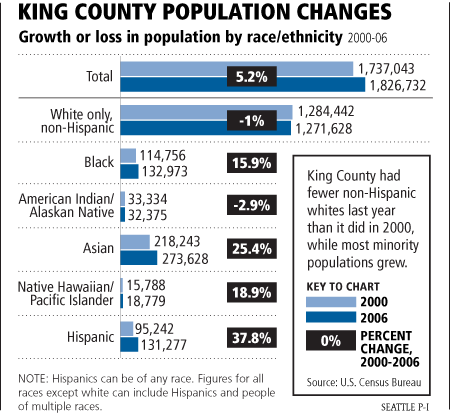
SEATTLE POST-INTELLIGENCER
Diversity grows as King County sees more minorities
Thursday, August 9, 2007
Last updated 1:59 p.m. PT
By AUBREY COHEN
P-I REPORTER
(Editor's note: This story has been changed since it was originally published. Adams, not Asotin county as indicated in the earlier version, is one of two Washington counties east of the Cascades in which non-Hispanic whites make up less than half the population.)
King County's population is becoming less and less white, although it's still far less diverse than many urban counties, according to data released Thursday.
White, non-Hispanic people accounted for slightly less than 70 percent of the county total as of July 1, 2006, according to new U.S. Census Bureau estimates. That's down from 74 percent in 2000. The number of non-Hispanic whites in the county declined 1 percent from 2000 to 2006, compared with increases of 5.2 percent statewide and 2.2 percent nationally.
In the same period, the county's number of Hispanics increased nearly 38 percent and the number of Asians went up more than 25 percent.
"King County reflects what's happening nationally: increasing diversity, increasing Latino population and, particularly in King County, an increase in the Asian population," said Chandler Felt, a demographer with King County's Office of Management and Budget.

Many minority residents who moved to King County in recent years list the typical reasons for coming to the region.
"My husband got laid off from his job, and we'd been talking about coming to Seattle for a while," said Debbie Woo, a Chinese-American who moved to Seattle from San Francisco three years ago.
Woo, who went to graduate school at the University of Washington years earlier, said she liked the area's beauty and its relatively low cost of living, compared with San Francisco; she also had a sister living in Seattle.
Malika Kirkling, an African-American architect intern from Columbus, Ohio, said she sought a job in Seattle because of her interest in environmentally conscious architecture.
"It seemed like it was actually gaining ground here," she said. "And I like the scale of the city."
People moving to the county from other countries during the recession from 2001 to 2004 helped its diversity, Felt said. The decline in the number of white non-Hispanics may have something to do with people leaving King County in search of cheaper housing, he said.
Despite increases in minority populations, many minorities who moved to King County in recent years say they have noticed less diversity compared with the places they left.
"It's definitely more diverse in Columbus," Kirkling said.
Seattle has diverse areas, but fewer than Columbus, she said, noting that she moved from Queen Anne to Capitol Hill in part because of diversity.
Woo's perspective is noticed. "You see a lot more diversity all throughout a city like San Francisco than you do here," she said.
San Francisco County held steady at just under 56 percent minority in recent years. And 34 percent of San Francisco County residents are at least partly Asian, compared with 15 percent of King County residents.
San Francisco's huge Asian-American population is represented in Japantown, Chinatown and Koreatown, compared with Seattle's one International District, said Woo, who lives in north Seattle.
Kirkling sometimes feels as if she stands out more in Seattle than she did in Columbus, she said. Although Franklin County, which includes Columbus, is slightly whiter than King County, black people represent about 21 percent of its population -- nearly three times their King County share.
Woo's husband, who is white, gets stares when he is walking around with their two children, whom the couple adopted from China, she said.
"You would probably get less of that in the Bay Area," she said.
Having smaller or less-established minority communities can bring other differences.
Kirkling said she has noticed less news coverage of the black community and events. "I don't remember hearing anything out here about Juneteenth," she said, referring to the June 19 observance of emancipation from slavery.
Woo had a different complaint.
"One of the things my sister and I lament is (that) the Chinese restaurants here are OK. They're not great," she said Wednesday. "My parents are coming into town today. ... We're actually going to Vancouver to get good Chinese food."
There are two Washington counties east of the Cascades in which non-Hispanic whites make up less than half the population: Adams and Franklin. There is nothing new in those figures, however. Non-Hispanic whites have been less than half the population of Franklin County since at least 2000, and Adams County minorities crossed the halfway point in 2002, according to Census Bureau figures.
Here are some nationwide highlights from minority population data the Census Bureau released Thursday.
Minorities, as a whole, made up the majority of the population in 303 of the nation's 3,141 counties in 2006, up from 295 in 2005.
Source: U.S. Census Bureau
P-I Reporter Daniel Lathrop contributed to this report. P-I reporter Aubrey Cohen can be reached at 206-448-8362 or aubreycohen@seattlepi.com.
© 1998-2007 Seattle Post-Intelligencer